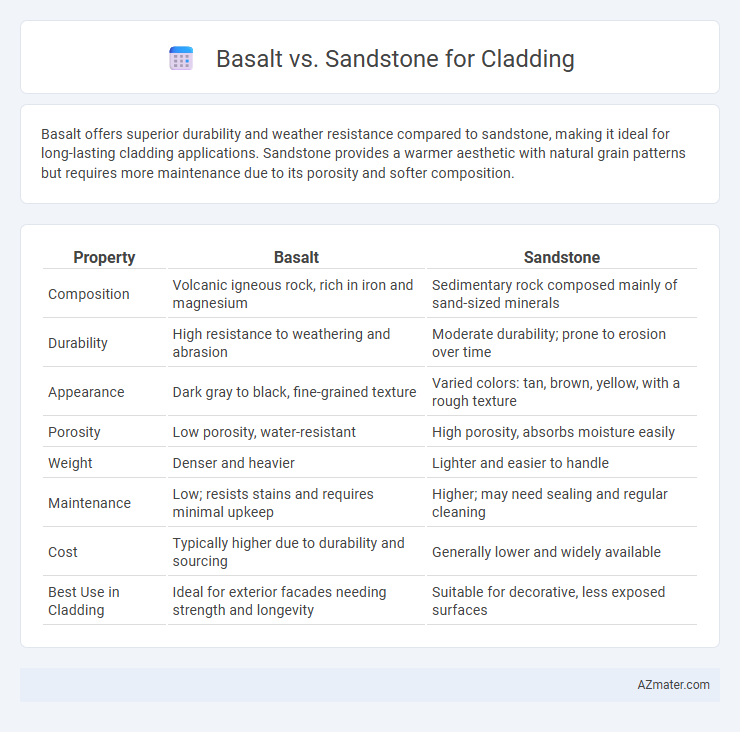Basalt offers superior durability and weather resistance compared to sandstone, making it ideal for long-lasting cladding applications. Sandstone provides a warmer aesthetic with natural grain patterns but requires more maintenance due to its porosity and softer composition.
Table of Comparison
| Property | Basalt | Sandstone |
|---|---|---|
| Composition | Volcanic igneous rock, rich in iron and magnesium | Sedimentary rock composed mainly of sand-sized minerals |
| Durability | High resistance to weathering and abrasion | Moderate durability; prone to erosion over time |
| Appearance | Dark gray to black, fine-grained texture | Varied colors: tan, brown, yellow, with a rough texture |
| Porosity | Low porosity, water-resistant | High porosity, absorbs moisture easily |
| Weight | Denser and heavier | Lighter and easier to handle |
| Maintenance | Low; resists stains and requires minimal upkeep | Higher; may need sealing and regular cleaning |
| Cost | Typically higher due to durability and sourcing | Generally lower and widely available |
| Best Use in Cladding | Ideal for exterior facades needing strength and longevity | Suitable for decorative, less exposed surfaces |
Introduction to Stone Cladding: Basalt vs Sandstone
Basalt and sandstone are popular natural stone options for cladding due to their distinct physical properties and aesthetic appeal. Basalt features a dense, fine-grained texture and dark gray to black hues, making it highly durable and weather-resistant for exterior applications. Sandstone offers a softer, porous structure with warm earthy tones, providing excellent insulation and a rustic look but requiring more maintenance to prevent erosion and staining.
Geological Origins of Basalt and Sandstone
Basalt originates from rapidly cooled lava flows, classified as an extrusive igneous rock, characterized by its fine-grained texture and high density, making it highly durable for cladding. Sandstone, a sedimentary rock formed from compacted sand grains cemented by minerals such as quartz or calcite, varies widely in porosity and strength depending on its geological composition. The volcanic origin of basalt provides superior resistance to weathering compared to the often more porous and softer sandstone, influencing the longevity and maintenance requirements of cladding materials.
Aesthetic Differences: Color, Texture, and Finish
Basalt cladding exhibits a deep, rich black or dark gray color with a fine-grained, smooth texture that offers a sleek and modern finish. Sandstone cladding features a warm, earthy palette ranging from beige to red, characterized by a coarse, grainy texture that provides a rustic and natural appearance. The finish of basalt tends to be matte or polished with a contemporary feel, whereas sandstone's finish is often matte or slightly rough, enhancing its organic and traditional aesthetic.
Durability and Strength Comparison
Basalt offers superior durability and strength compared to sandstone due to its volcanic origin, resulting in a dense, hard material that resists weathering and impact damage effectively. Sandstone, being sedimentary, is softer and more porous, making it more susceptible to erosion, chipping, and moisture absorption over time. For cladding applications, basalt's higher compressive strength and abrasion resistance provide a long-lasting, low-maintenance solution ideal for harsh environments.
Weather Resistance and Longevity
Basalt offers superior weather resistance compared to sandstone due to its volcanic origin and dense, non-porous structure, making it highly resilient against freeze-thaw cycles and erosion. Sandstone, while visually appealing with its natural grains and colors, is more porous and susceptible to water absorption, leading to potential weathering and reduced longevity over time. For cladding applications requiring durability and low maintenance, basalt is often preferred for its hardness, longevity, and exceptional performance in harsh weather conditions.
Installation Challenges and Best Practices
Basalt cladding poses installation challenges due to its dense, heavy composition requiring specialized cutting tools and reinforced anchoring systems to ensure stability. Sandstone, being softer and more porous, demands careful handling to prevent chipping and moisture penetration during installation, alongside the use of breathable membranes to avoid trapped water. Best practices include precise measurements and prefabrication for basalt panels, while sandstone cladding benefits from sealing treatments and stainless-steel fixings to enhance durability and aesthetic longevity.
Maintenance Requirements for Basalt and Sandstone Cladding
Basalt cladding requires minimal maintenance due to its high resistance to weathering, staining, and erosion, making it ideal for long-term exterior applications. Sandstone cladding, while aesthetically versatile, demands more regular sealing and cleaning to prevent moisture absorption, moss growth, and surface degradation. Proper maintenance routines extend the lifespan of both materials, but basalt's durability significantly reduces overall upkeep efforts.
Cost Comparison and Budget Considerations
Basalt cladding typically incurs higher upfront costs compared to sandstone due to its density and durability, but offers longer-term value with superior weather resistance and minimal maintenance. Sandstone, being more affordable and easier to quarry and install, suits budget-conscious projects but may require more frequent upkeep and potential replacement over time. Project budgets should balance initial investment with lifecycle costs, factoring in basalt's premium price against sandstone's lower acquisition cost and maintenance demands.
Environmental Impact and Sustainability
Basalt cladding offers superior environmental benefits due to its natural abundance, durability, and low energy requirements in processing compared to sandstone. Sandstone, while aesthetically pleasing, often involves higher carbon emissions during extraction and transportation because of its lower density and fragility. Sustainable building projects favor basalt for its longer lifespan and minimal maintenance needs, which reduce resource consumption and ecological footprint over time.
Choosing the Right Stone: Basalt or Sandstone for Your Project
Basalt offers exceptional durability and weather resistance, making it ideal for high-traffic or exposed cladding applications, while sandstone provides a softer, warmer aesthetic with excellent natural texture and color variation suited for decorative or traditional designs. Basalt's fine-grained structure resists abrasion and moisture absorption, enhancing longevity, whereas sandstone's porous nature requires sealing to prevent staining and erosion. Selecting between basalt and sandstone depends on project requirements for durability, maintenance, and desired visual impact.

Infographic: Basalt vs Sandstone for Cladding
 azmater.com
azmater.com